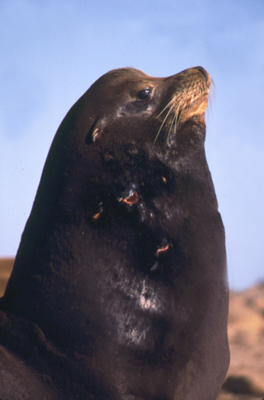Project Description
 Hookworm disease has emerged as a probable regulator of the growth of the San Miguel Island California sea lion and northern fur seal populations. This disease has caused first year survival to decline from 65% to 35% for sea lions and well below 50 % for northern fur seals. This demographic shift has caused there to be lower recruitment of females and decreased numbers of pups born such that the population growth is now near zero for sea lions. Hookworm disease in sea lions is characterized by an enteritis/bacteremia complex with the bacterial infections being the proximate cause of the mortality. It was not known whether hookworm disease is causing as great of pup mortality at the other three California sea lion rookeries in the Channel Islands, but mortality surveys and hookworm disease studies were initiated at San Nicolas Island in 2005. Results of those studies indicate mortality may be less than half what is being recorded at San Miguel Island. Yet in all dead pups examined at San Nicolas hookworms were prevalent and the pups died of the same causes as were seen San Miguel Island. In northern fur seals hookworm disease has been apparent but it has caused only a moderate amount of mortality until recently when up to half of the pups born in Adams Cove at San Miguel Island have died within 2 months of birth. This is the first case where there has been sufficient scientific information to demonstrate that a density dependent disease is capable of regulating an Otariid pinniped population.
Hookworm disease has emerged as a probable regulator of the growth of the San Miguel Island California sea lion and northern fur seal populations. This disease has caused first year survival to decline from 65% to 35% for sea lions and well below 50 % for northern fur seals. This demographic shift has caused there to be lower recruitment of females and decreased numbers of pups born such that the population growth is now near zero for sea lions. Hookworm disease in sea lions is characterized by an enteritis/bacteremia complex with the bacterial infections being the proximate cause of the mortality. It was not known whether hookworm disease is causing as great of pup mortality at the other three California sea lion rookeries in the Channel Islands, but mortality surveys and hookworm disease studies were initiated at San Nicolas Island in 2005. Results of those studies indicate mortality may be less than half what is being recorded at San Miguel Island. Yet in all dead pups examined at San Nicolas hookworms were prevalent and the pups died of the same causes as were seen San Miguel Island. In northern fur seals hookworm disease has been apparent but it has caused only a moderate amount of mortality until recently when up to half of the pups born in Adams Cove at San Miguel Island have died within 2 months of birth. This is the first case where there has been sufficient scientific information to demonstrate that a density dependent disease is capable of regulating an Otariid pinniped population.
Issues & Justification
Beginning in 2005 and continuing through 2007 there has been a decrease in California sea lion pup mortality from hookworm disease, but during that same time period northern fur seal pup mortality has increased and will reach 70 % of pups born in 2007. Most of this mortality is assumed to result from hookworm disease, but there are not sufficient necropsy data to support the assumption. In 2006 northern fur seal and California sea lion pups were treated with Ivermectin, an anthelmenthic drug. An identical number of control pups were treated with saline as a placebo. Both experimental and control pups were tagged. Northern fur seals pups were treated when about 2 weeks old. The recovery of tagged dead fur seals indicated that five times as many fur seal pups in the control group died compared to the experimental group and growth to 3 months of age was significantly greater for the pups in the experimental group. Sea lion pups which were treated with Ivermectin at 1.5 to 2 months of age did not show significant differences in mortality or growth to 4 months of age when compared with controls. In 2007 a group of sea lion pups were treated with either ivermectin or a saline placebo injected subcutaneously when the pups were about 2-3 weeks old. All pups were tagged; preliminary results indicate increased survival in the treated group. This study will not be completed until December 2007. The development of an efficacious treatment protocol for sea lions is seen as a tool which may be applicable to future recovery efforts for Steller sea lions.
Goals
- Assess level of hookworm disease induced sea lion pup mortality at Santa Brabara and San Clemente Islands.
- Assess prevalence of hookworm disease among dead fur seal pups at San Miguel Island.
- Assess the prevalence of enteric pathogenic bacteria in northern fur seal and California sea lion pups.
Methods
The ivermectin study ('worming' seal pups with an anthelmenthic drug) was repeated in FY 2007 with California sea lion pups to assess whether it improves pup survival from hook worm disease. Mortality of tagged pups in the treated and control group will be monitored through December 2007. Weights of pups in the experimental and control group will be assessed in October 2007 to evaluate differences in growth rates.
Mortality surveys and a series of necropsy studies of pups will be conducted to assess the role of hookworm disease in fur seal pup mortality during the summer 2008 breeding season. A sample of 30 dead pups from early, mid and late season will be necropsyed to assess the causes of death, the prevalence of hookworm disease and associated bacterial pathogens.

